When it comes to pest control, bed bugs can be one of the most difficult pests to deal with. They are small, elusive creatures that are notorious for causing bites and infesting furniture and other household items.
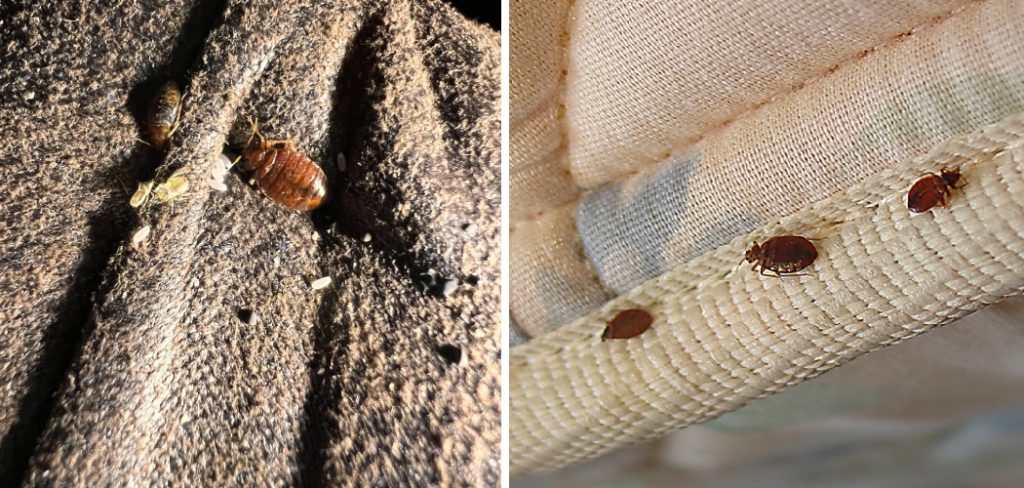
If you suspect that your couch may have a bed bug infestation, don’t panic – there are steps you can take to identify and get rid of them. In this guide on how to look for bed bugs on couches, we will provide you with some useful tips and tricks to help you keep your home bed bug-free.
Necessary Items
Before starting your search for bed bugs on your couch, you will need some essential items to help you with the process. These include:
- A Flashlight: Bed bugs are nocturnal creatures and tend to hide in dark spaces, so having a bright light source is crucial.
- A Credit Card or Similar Flat Object: This will come in handy when inspecting crevices and seams of the couch.
- A Magnifying Glass: Bed bugs are small, so a magnifying glass can help you spot them more easily.
- Rubbing Alcohol: This will be used to kill any bed bugs or eggs that you may find during your search.
8 Things to Know Before You Start
1) Know What You’re Looking For
Before you begin your search, it’s essential to know what bed bugs look like and how they behave. Adult bed bugs are reddish-brown in color and about the size of an apple seed. They have flat, oval bodies and six legs that allow them to move quickly between surfaces.
2) Understand Their Habits
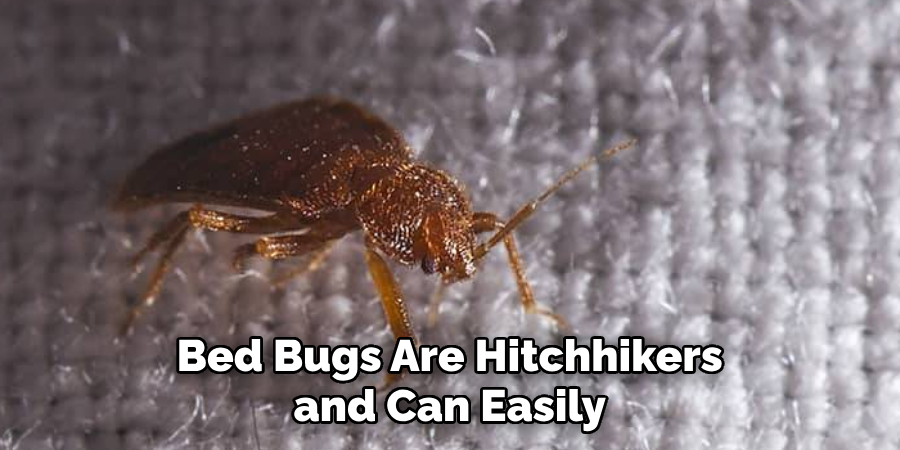
Bed bugs are hitchhikers and can easily be transported from one location to another on clothing, luggage, or furniture. They also tend to hide during the day and come out at night to feed on human blood.
3) Be Thorough
Bed bugs can hide in tight spaces and crevices, so it’s crucial to inspect your couch thoroughly. Don’t overlook any seams, zippers, or folds in the fabric. Remember to check the underside of the couch and any other furniture nearby.
4) Don’t Rush
Inspecting for bed bugs on your couch can take some time, so don’t rush through it. Take your time and be thorough in your search. But also don’t spend too much time in one area, as bed bugs can quickly move to another location if they sense danger.
5) Check for Signs of Bed Bugs
Aside from the actual bugs themselves, there are other signs that may indicate a bed bug infestation on your couch. These include blood spots or fecal stains on the fabric and shed skins or eggs. As bed bugs molt as they grow, you may also find their exoskeletons on the couch.
6) Don’t Use Pesticides
While it may be tempting to use pesticides to get rid of bed bugs, it’s not recommended. These chemicals can be harmful to your health and may not even effectively kill all the bugs and eggs hiding in your couch.
7) Use Protective Gear
To protect yourself from potential bed bug bites, it’s a good idea to wear gloves and long sleeves while inspecting. You may also want to consider wearing a mask to avoid breathing in any dust or debris that may be stirred up during the process. And after you’re done, make sure to thoroughly wash your hands and clothing.
8) Don’t Panic If You Find Bed Bugs
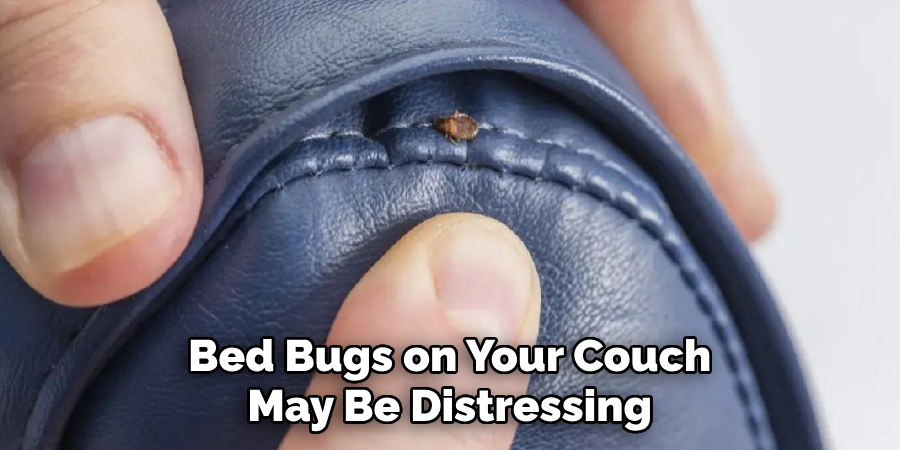
Finding bed bugs on your couch may be distressing, but it’s not the end of the world. With proper treatment and prevention methods, you can effectively get rid of them and prevent future infestations. It’s best to contact a professional pest control service for help in dealing with these pesky bugs.
While bed bugs can be a nuisance, they are not impossible to get rid of. By following these steps on how to look for bed bugs on couch and taking necessary precautions, you can effectively look for bed bugs on your couch and prevent them from spreading to other areas of your home. Remember to always be thorough in your search, use protective gear, and seek professional help if needed. Stay vigilant and keep your home bed bug-free!
8 Signs of Bed Bugs on Couches
Before we dive into the steps for identifying bed bugs on couches, let’s first go over some common signs that may indicate an infestation:
1) Bite Marks
Bed bug bites can be difficult to differentiate from other insect bites, but they typically have a red, raised, and itchy appearance. You may also notice multiple bites in a straight line or zigzag pattern. Also, keep in mind that not everyone reacts to bed bug bites, so you may not see any visible marks.
2) Blood Stains
After feeding on human blood, bed bugs can leave behind small blood stains or smears on the fabric of your couch. These stains may be dark red or brown in color and are usually found near where the bugs feed.
3) Fecal Stains
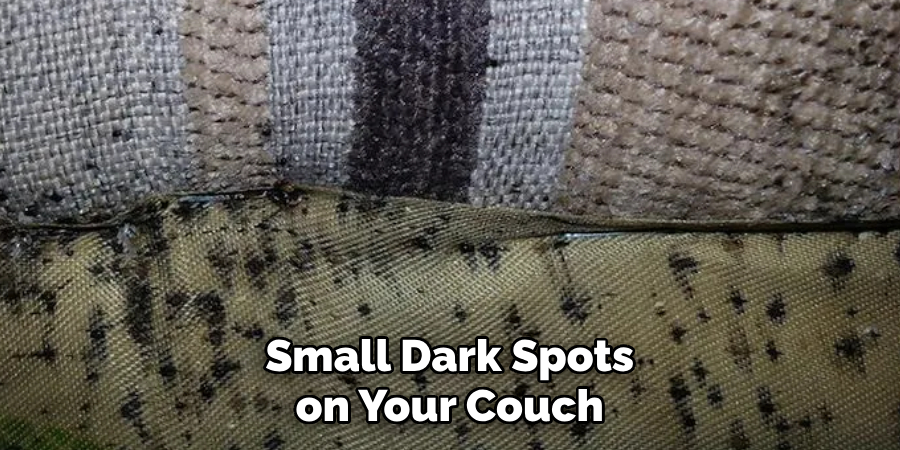
Bed bugs also excrete fecal matter, which can appear as small dark spots on your couch. These stains may be found on the surface of the fabric or in seams and crevices. If you notice these stains, it’s a good indication that bed bugs are present.
4) Shed Skins
As mentioned earlier, bed bugs molt as they grow and shed their exoskeletons. These discarded skins can be found on your couch and may look like small, translucent shells. Then, they are a sign that there is an active infestation.
5) Eggs
Bed bugs lay their eggs in small batches of 1-5 at a time and are about the size of a pinhead. These white or cream-colored eggs can be found in crevices, seams, and other hidden areas on your couch.
6) Unpleasant Odor
Bed bugs release a musty, sweet odor from their scent glands. If you notice a strange smell coming from your couch, it may be a sign of a large infestation. And the longer the infestation has been present, the stronger and more unpleasant the smell can become.
7) Live Bed Bugs
Of course, if you spot live bed bugs on your couch, it’s a clear sign that there is an active infestation. These bugs are small, but they are visible to the naked eye and may be crawling on the surface of your couch or hiding in crevices and seams.
8) Rusty or Black Spots on Furniture
Bed bugs can also leave behind rust-colored spots from their droppings, which are often noticeable on light-colored furniture. They may also leave behind black fecal stains, which are a sign that the infestation is active and growing.
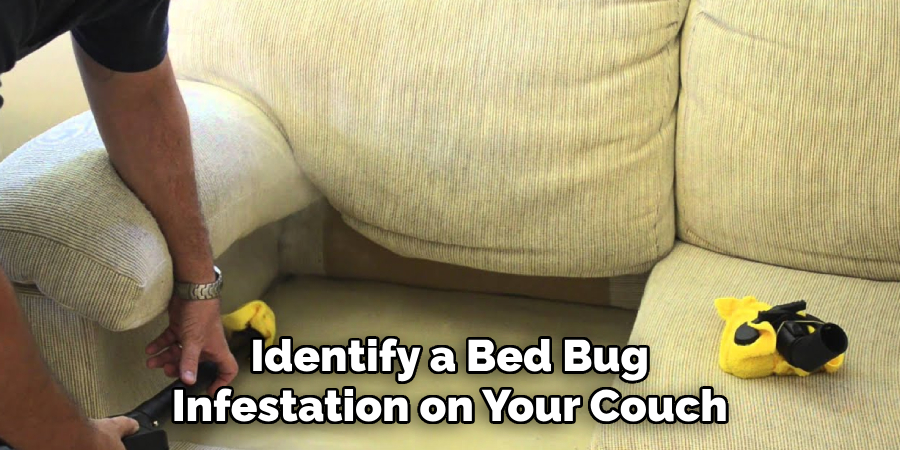
Knowing these signs can help you identify a bed bug infestation on your couch and take the necessary steps to address the problem. Remember to always be thorough in your inspection and seek professional help if needed. So, don’t panic if you find any of these signs; just act quickly and effectively to rid your home of these pesky bugs. Keep your couch clean and regularly inspect it for any signs of bed bugs to prevent infestations in the future. Prevention is key when it comes to dealing with these tiny pests.
12 Steps on How to Look for Bed Bugs on Couch
Step 1: Strip the Couch
The first step in inspecting for bed bugs on your couch is to remove all cushions, pillows, and covers. Place them in a garbage bag or sealed container for further inspection. As you strip the couch, be sure to check for any signs of bed bugs on the fabric and seams.
Step 2: Vacuum Thoroughly
Using a vacuum with a high-efficiency particulate air (HEPA) filter, thoroughly vacuum your couch. Pay special attention to crevices, seams, and other hidden areas where bed bugs may hide. While vacuuming, make sure to discard the bag or empty the canister into a sealed container to prevent any bed bugs from escaping.
Step 3: Use a Steam Cleaner
If possible, use a steam cleaner on your couch. The high temperatures of steam can effectively kill bed bugs and their eggs. So, run the steam cleaner over every inch of your couch, including seams, crevices, and cushions.
Step 4: Use a Flashlight
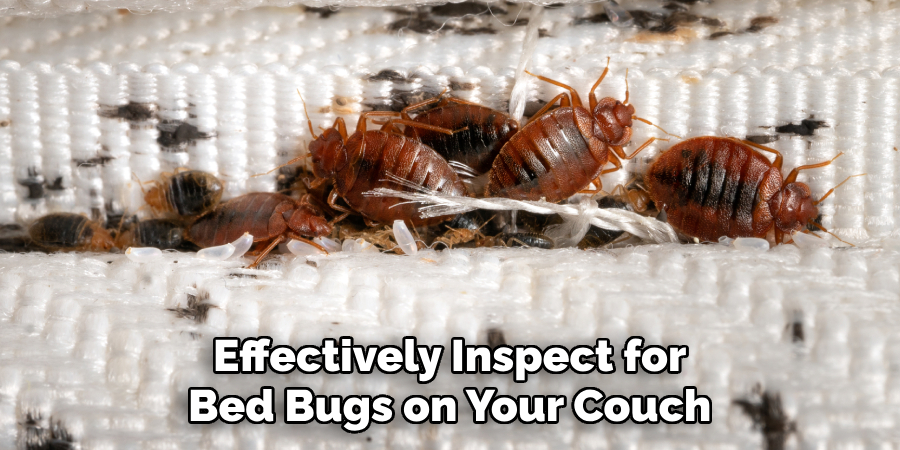
To effectively inspect for bed bugs on your couch, you’ll need a flashlight to help you see hidden areas. Make sure to use a bright LED light for better visibility. Even in well-lit rooms, bed bugs can easily hide in dark crevices and seams.
Step 5: Check the Frame
Using your flashlight, inspect the frame of your couch for any signs of bed bugs. Look for cracks, crevices, and other hiding spots where these pesky bugs may be present. You may also want to consider using a tool like a credit card to scrape along the frame and dislodge any bed bugs that may be hiding.
Step 6: Examine the Cushions
Next, examine each cushion carefully for any signs of bed bugs. Use your flashlight to check inside seams, zippers, and other hidden areas. Pay special attention to the piping around the edges of cushions, as these are common hiding spots for bed bugs.
Step 7: Inspect the Seams and Tufts
With your flashlight, carefully inspect all seams and tufts on your couch. Bed bugs may hide in these hard-to-reach areas and can be difficult to spot with the naked eye. You may also want to use a tool like a credit card or cotton swab to push into seams and dislodge any bed bugs hiding inside.
Step 8: Check for Eggs
Remember to keep an eye out for any small, white, or cream-colored eggs. These can be found in crevices, seams, and other hidden areas on your couch. Using a magnifying glass can help you spot these tiny eggs more easily.
Step 9: Look for Stains
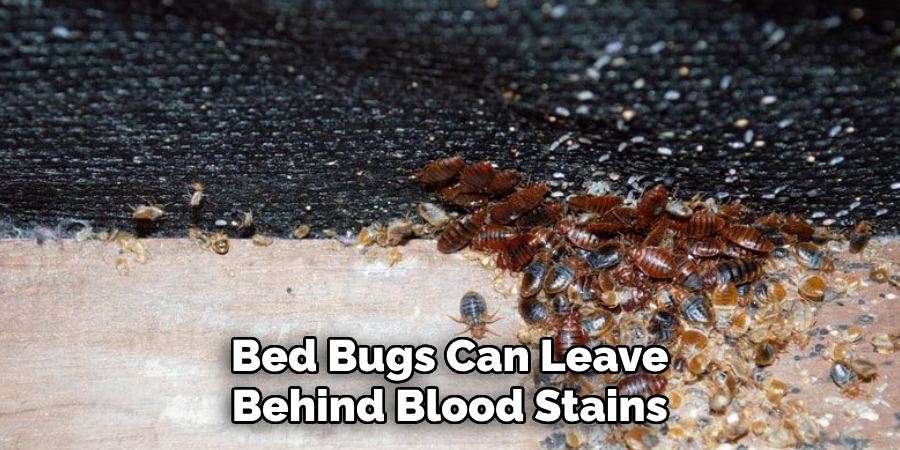
As mentioned earlier, bed bugs can leave behind blood stains, fecal spots, and shed skin. Use your flashlight to carefully inspect the fabric of your couch for any signs of these stains. Don’t forget to check both sides of the cushions and pillows.
Step 10: Use Bed Bug Traps
To help monitor for any bed bugs that may still be present on your couch, you can also use bed bug traps. These are small containers or discs with an adhesive surface that attract and trap bed bugs. Place these under the legs of your couch to help detect any remaining bugs.
Step 11: Reassemble Your Couch
After thoroughly inspecting and treating your couch for bed bugs, it’s time to reassemble it. Before doing so, make sure to clean and treat any infested items or furniture that may have been in contact with your couch.
Step 12: Monitor for Reinfestation
Even after taking all the necessary steps to rid your couch of bed bugs, it’s important to continue monitoring for any signs of re-infestation. Regularly inspect your couch and other furniture for any signs of bed bugs, and take immediate action if you suspect a new infestation. With diligence and persistence, you can keep your home free of these unwanted pests!
Keep in mind that it may take multiple treatments to completely eradicate an infestation, so be patient and thorough in your approach. Don’t hesitate to seek professional help if needed as well. Prevention and early detection are key to successfully dealing with bed bugs on your couch and in your home. Stay vigilant, and don’t let these pesky bugs take over your comfortable furniture! So, remember to regularly inspect your couch for any signs of bed bugs and take necessary steps to keep them at bay.
8 Things to Avoid to Prevent Bed Bug Infestations on Your Couch
1) Avoid Buying Used or Second-hand Furniture
Used furniture, especially couches, can be a prime breeding ground for bed bugs. It’s best to avoid purchasing used furniture to prevent bringing any unwanted pests into your home. And if you do decide to buy used furniture, be sure to thoroughly inspect it for any signs of bed bugs before bringing it into your home.
2) Don’t Leave Clutter Around the Couch
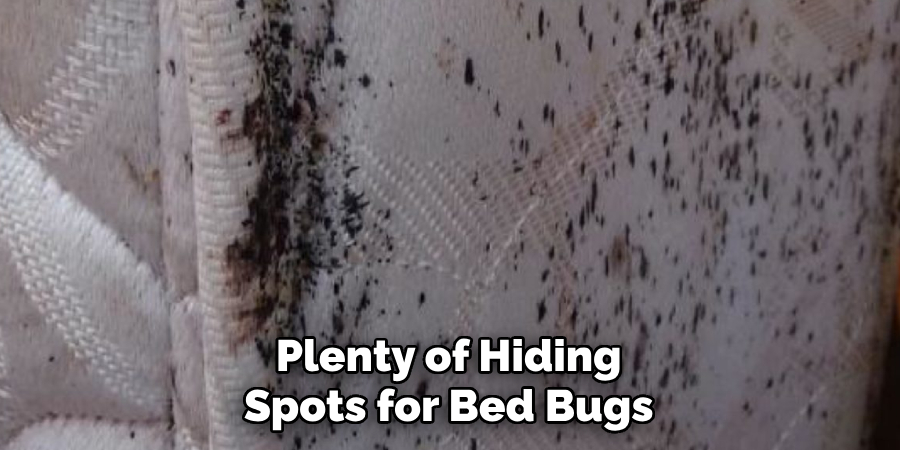
Clutter provides plenty of hiding spots for bed bugs, making it easier for them to infest your couch. Keep the area around your couch clean and clutter-free to prevent any bed bugs from taking up residence.
3) Avoid Placing Your Luggage on the Couch
After traveling, be cautious about where you place your luggage. Placing it directly on your couch can increase the risk of bringing bed bugs into your home. Instead, opt for a hard surface or use a luggage rack to keep your bags off the ground.
4) Don’t Bring Used Clothing onto the Couch
Used clothing can also harbor bed bugs, so avoid bringing them onto your couch. If you need to sort through or fold used clothes, do it on a hard surface and avoid contact with your couch. Always wash any used clothing before storing or wearing them.
5) Avoid Using Public Laundromats
Using public laundromats to wash your clothes, blankets, or other items that come in contact with your couch can also increase the risk of bed bug infestations. If possible, use your own washer and dryer at home to reduce the chance of picking up any unwanted pests.
6) Don’t Ignore Signs of Bed Bugs
If you notice any signs of bed bugs on your couch, such as blood stains or shed skin, don’t ignore them. Take immediate action to prevent the infestation from spreading and becoming harder to control.
7) Avoid Using DIY Methods Alone
While DIY methods can be effective in treating bed bugs, it’s best to seek professional help when dealing with a large or stubborn infestation. Don’t rely solely on DIY methods; instead, consider hiring a pest control professional for thorough and effective treatment.
8) Don’t Panic
Dealing with bed bugs can be stressful, but it’s important not to panic. With patience, diligence, and proper treatment methods, you can successfully get rid of bed bugs on your couch and keep them from coming back. Stay informed and proactive in preventing and treating bed bug infestations to ensure a comfortable and pest-free home.
Keep these tips on how to look for bed bugs on couch in mind to protect yourself and your couch from unwanted bed bugs. It’s important to regularly inspect your couch for any signs of bed bugs and take necessary steps to prevent, monitor, and treat infestations.
With diligence and proper precautions, you can keep your couch and home free from these pesky pests. And remember, if you need help in dealing with a bed bug infestation on your couch or elsewhere in your home, don’t hesitate to seek professional assistance.
Frequently Asked Questions About Bed Bugs on Couches
Can Bed Bugs Live in Couch Cushions?
Yes, bed bugs can hide and live in the seams, crevices, and folds of your couch cushions. They can also lay their eggs in these areas, making it important to thoroughly inspect and treat couch cushions when dealing with a bed bug infestation.
Can Bed Bugs Live Only on Couches?
No, bed bugs can live in various locations, including mattresses, carpets, and other furniture. Couches are just one of the many places they may infest. It’s important to regularly inspect your entire home for any signs of bed bugs to prevent and treat infestations.
Can I Use Essential Oils or Home Remedies to Get Rid of Bed Bugs on My Couch?
While there are some natural remedies that may help repel or kill bed bugs, they may not be as effective as professional treatment methods. If you choose to use essential oils or other home remedies, be sure to thoroughly research and carefully follow instructions. It’s also important to note that these methods may not completely eradicate a bed bug infestation.
Can I Prevent Bed Bugs from Infesting My Couch Again in the Future?
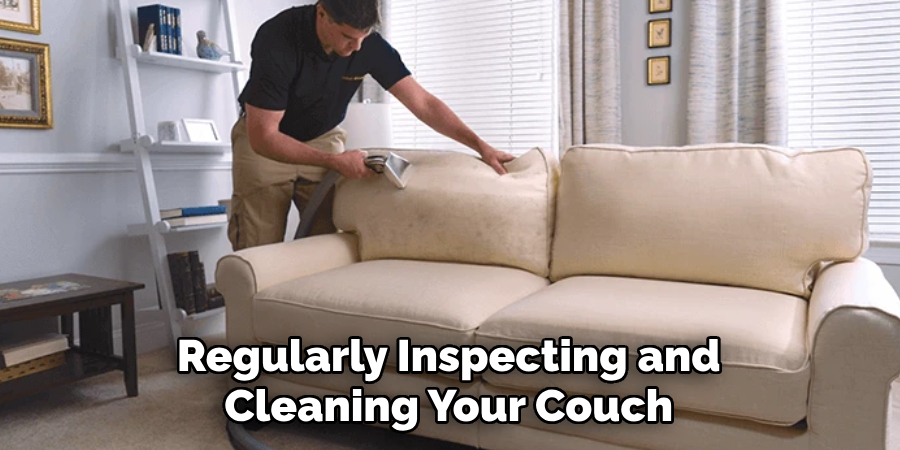
Yes, by following the tips mentioned above, you can greatly reduce the chances of having another bed bug infestation on your couch. Regularly inspecting and cleaning your couch and taking precautions when traveling or bringing in used items can help prevent bed bugs from infesting your couch again.
Conclusion
Bed bugs on couches can be a nightmare to deal with, but with the right knowledge on how to look for bed bugs on couch and precautions, you can successfully prevent and treat infestations.
Regularly inspecting your couch and taking the necessary steps to keep it bed bug-free is key in protecting your home from these pesky pests. And remember, don’t hesitate to seek professional help if needed for effective treatment. Keep your couch and home pest-free for a comfortable and relaxing living space.

